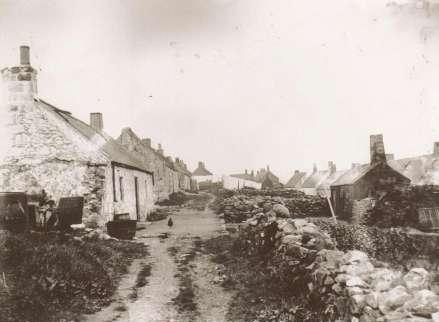
|
In the introduction of this website I mentioned “When we were young the coast from Findon Ness to Downies Haven, and sometimes beyond, was our playground where we learned about the cliffs, the rocks and the ways of the sea”, and it’s at this point I’ll introduce you to the people who were part of the gang that utilised our coast as that playground whilst we were “growing up”.
This particular section is self indulgent and nostalgic, and is likely to be of little interest to anyone apart from the individuals that were in the gang. As a result I’ve developed this section purely for my old friends who may or may not stumble across this website by accident – I also want to thank them here and make acknowledgement in respect to the part that they played in the past and the influence they have had in aiding me in the development of this website.
As well as myself there were five other kids that stayed in or visited Portlethen Village on a regular basis. These kids made sure that our summers were filled with action and adventure and even during those weekends out with the summer months we were rarely at a loss in respect to finding something to do. Invariably this meant trips up and down the coast, cliff climbing, searching for bird eggs, fishing from the rocks, constant trips out to sea in clinker built boats and the building and burning of a “bondie” on a regular basis.
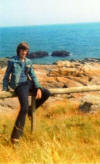 There have already been references to my brother Ron
scattered throughout this website so I don’t need to say much more other
than he was very much part of our gang. He is still very much a local
lad and is well known for the stone building work that he has done in
the area – have a look at the small bridges at Portlethen golf course
and some of the rebuilt stone dykes in the area and the chances are
those are examples of his work (if not, chances are they are some of my
father’s work). Ron is still very much a local “worthie”, despite
occasional forays over to India, and can often be found fishing in the
family boat of the coast of Portlethen during the summer months.
There have already been references to my brother Ron
scattered throughout this website so I don’t need to say much more other
than he was very much part of our gang. He is still very much a local
lad and is well known for the stone building work that he has done in
the area – have a look at the small bridges at Portlethen golf course
and some of the rebuilt stone dykes in the area and the chances are
those are examples of his work (if not, chances are they are some of my
father’s work). Ron is still very much a local “worthie”, despite
occasional forays over to India, and can often be found fishing in the
family boat of the coast of Portlethen during the summer months.
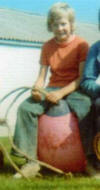 Martin Craig, a descendant of the old fishing fraternity
that used to stay in Portlethen was a key part of the gang. He later
developed a nickname, Trampas, due to his liking for Westerns and, in
particular, the character played by Doug McLure in “The Virginian”. What
can I say about Trampas? He was an amazing climber with incredible
balancing skills – could just about climb any cliff between Downies and
Portlethen without any sign of fear. As well as his skills on the rocks
he carried a good bit of luck too – the one time he did encounter a
thirty foot fall from a rock at Arnot Boo onto another one protruding
from just below the surface of the sea he landed with legs splayed
either side of the protruding rock and sustained no damage whatsoever!
Trampas, like Ron and me, had access to a family boat - one owned by his
uncle, so we often competed with each other in creel fishing to see who
could catch the most lobsters and if memory serves me correctly Trampas
always did manage to catch more than us. Why was that? Better creels?
More knowledge? Inside information? Maybe it would be best to ask that
question to the older lobster fishermen that were working creels locally
at the same time because it would appear that Trampas was less than
popular with one or two of them and his catch of lobsters would
occasionally surpass theirs. I wonder why??? I still see Martin
occasionally when he pays occasional visits to Portlethen Village in the
summer to try his hand at the lobster creels for a few weeks. Nowadays
we compete in our lobster fishing on an even playing field!
Martin Craig, a descendant of the old fishing fraternity
that used to stay in Portlethen was a key part of the gang. He later
developed a nickname, Trampas, due to his liking for Westerns and, in
particular, the character played by Doug McLure in “The Virginian”. What
can I say about Trampas? He was an amazing climber with incredible
balancing skills – could just about climb any cliff between Downies and
Portlethen without any sign of fear. As well as his skills on the rocks
he carried a good bit of luck too – the one time he did encounter a
thirty foot fall from a rock at Arnot Boo onto another one protruding
from just below the surface of the sea he landed with legs splayed
either side of the protruding rock and sustained no damage whatsoever!
Trampas, like Ron and me, had access to a family boat - one owned by his
uncle, so we often competed with each other in creel fishing to see who
could catch the most lobsters and if memory serves me correctly Trampas
always did manage to catch more than us. Why was that? Better creels?
More knowledge? Inside information? Maybe it would be best to ask that
question to the older lobster fishermen that were working creels locally
at the same time because it would appear that Trampas was less than
popular with one or two of them and his catch of lobsters would
occasionally surpass theirs. I wonder why??? I still see Martin
occasionally when he pays occasional visits to Portlethen Village in the
summer to try his hand at the lobster creels for a few weeks. Nowadays
we compete in our lobster fishing on an even playing field!
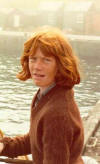 Steve Bates is another person from the past, my long time
friend, and someone who still stays in Portlethen Village today. It was
Steve’s house where we would invariably congregate when the weather was
bad and we continued to get together there throughout the 1980’s and
1990’s, and long after our teenage years. I think we’re all still
indebted to Elspeth and Hamish, his parents, for putting up with us
during many rainy days and late nights. As well as Steve, his dog Saga,
was also an honorary member of the gang and accompanied us on long
rambles across the rocks and out in the boats. I do recall one occasion
when we were up to mischief, the police were on our trail, we all
escaped and the only one captured was the dog. Faithfully, Saga never
said a word and we all made good our escape. Steve’s penchant was for
wild animals, insects and sea life and he was forever exploring, turning
over rocks and boulders and looking for a new animal “discovery”. It’s
not surprising that today Steve has a strong interest in reptiles and in
the past has owned and looked after other exotic animals such as snakes
and tarantulas. That much hasn’t changed and the only difference now is
the “beasties” he keeps are a lot larger in size than the collections he
had as a kid.
Steve Bates is another person from the past, my long time
friend, and someone who still stays in Portlethen Village today. It was
Steve’s house where we would invariably congregate when the weather was
bad and we continued to get together there throughout the 1980’s and
1990’s, and long after our teenage years. I think we’re all still
indebted to Elspeth and Hamish, his parents, for putting up with us
during many rainy days and late nights. As well as Steve, his dog Saga,
was also an honorary member of the gang and accompanied us on long
rambles across the rocks and out in the boats. I do recall one occasion
when we were up to mischief, the police were on our trail, we all
escaped and the only one captured was the dog. Faithfully, Saga never
said a word and we all made good our escape. Steve’s penchant was for
wild animals, insects and sea life and he was forever exploring, turning
over rocks and boulders and looking for a new animal “discovery”. It’s
not surprising that today Steve has a strong interest in reptiles and in
the past has owned and looked after other exotic animals such as snakes
and tarantulas. That much hasn’t changed and the only difference now is
the “beasties” he keeps are a lot larger in size than the collections he
had as a kid.
 Doug Milne, a long time summertime visitor, who made the
long trek out to Portlethen from Kincorth every weekend to stay with his
grandfather in Old Portlethen, was another integral part of the gang. He
may have been the oldest in the gang but that didn’t mean he was
necessarily the smartest and he was just as likely to get up to mischief
or do something incredibly daft or mind blowing (I mean that in the best
possible way Doug!). Therefore it wasn’t surprising to discover him
taking up extreme pastimes such as parachute jumping and bungee jumping
later on in life. Doug was also the bonfire king and could always rustle
up a bonfire without much in the way of help – I’m sure he could do all
the Indian tricks such as rubbing sticks and knocking stones together
and would be guaranteed a spark to start a fire. Today Doug runs his own
building business and stays near Findon, albeit he’s a bit closer to the
main road than he is to the sea these days.
Doug Milne, a long time summertime visitor, who made the
long trek out to Portlethen from Kincorth every weekend to stay with his
grandfather in Old Portlethen, was another integral part of the gang. He
may have been the oldest in the gang but that didn’t mean he was
necessarily the smartest and he was just as likely to get up to mischief
or do something incredibly daft or mind blowing (I mean that in the best
possible way Doug!). Therefore it wasn’t surprising to discover him
taking up extreme pastimes such as parachute jumping and bungee jumping
later on in life. Doug was also the bonfire king and could always rustle
up a bonfire without much in the way of help – I’m sure he could do all
the Indian tricks such as rubbing sticks and knocking stones together
and would be guaranteed a spark to start a fire. Today Doug runs his own
building business and stays near Findon, albeit he’s a bit closer to the
main road than he is to the sea these days.
Finally we had Chris Campbell, an honorary member of the
gang although he always claimed an affinity to Downies, having stayed at
Longhillock Cottages on the road to that village. Chris was another who
regularly came out to sea with us and was particularly talented at
rowing – always a good guy to have around when the outboard engine
packed up and we had a long way to row home (this seemed to be a regular
occurrence if we were at Newtonhill in the boat).
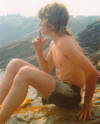 Chris’s other talent
was his ability to throw stones great distances – didn’t matter that he
wasn’t the biggest or heaviest amongst us, his ability to launch a stone
way beyond everyone else was legendary. He took that talent even further
by becoming a master of the sling shot and I recall one local fisher
being totally unaware as Chris launched a sling shot from over 600 yards
over and beyond him as he sailed, pipe in mouth, into the mouth of Portlethen shore. I think Chris got a bigger shock by discovering just
how far he could launch a stone whether by hand or by sling. Chris’s
family still stays locally although he himself stays in town and I
haven’t seen him for a number of years.
Chris’s other talent
was his ability to throw stones great distances – didn’t matter that he
wasn’t the biggest or heaviest amongst us, his ability to launch a stone
way beyond everyone else was legendary. He took that talent even further
by becoming a master of the sling shot and I recall one local fisher
being totally unaware as Chris launched a sling shot from over 600 yards
over and beyond him as he sailed, pipe in mouth, into the mouth of Portlethen shore. I think Chris got a bigger shock by discovering just
how far he could launch a stone whether by hand or by sling. Chris’s
family still stays locally although he himself stays in town and I
haven’t seen him for a number of years.
These were the kids that made up the gang that explored and exploited the lands and coasts close to our homes during the 1960’s and 1970’s.
One of our favourite pastimes was creating bonfires up and down the coast above the high water mark and we’d utilise drift wood and a variety of flotsam and jetsam that washed up regularly on the rocks and bays between Portlethen and Downies. Not for us only the annual Guy Fawkes bonfire on the 5th of November each year and we had plenty of practise in the art of building and burning bonfires throughout the year as we explored the local coastline. Nowadays kids don’t go out anywhere without being accompanied by their mobile phones and IPod’s but in our day our “must have accessory” was a box of Scottish Bluebell matches!
 Of course some locations were more attractive than others
in respect to where we had our bonfires, the most popular sites being
those where there was a beach or flat area where we could sit around the
fire although perhaps the most important “ingredient” was the closeness
of wood and other appropriate materials to build a fire – we didn’t want
to search and climb too far to gather the necessary materials.
Of course some locations were more attractive than others
in respect to where we had our bonfires, the most popular sites being
those where there was a beach or flat area where we could sit around the
fire although perhaps the most important “ingredient” was the closeness
of wood and other appropriate materials to build a fire – we didn’t want
to search and climb too far to gather the necessary materials.
It was amazing what you could find during a spot of beachcombing and gathering of bonfire material – not only was there a variety of different qualities of woods in all shapes and forms such as cut planks, fish boxes and trunks and branches of trees, there was an array of other materials such as ropes, nets, floats, wrecked creels, plastic containers, bits of clothing, shoes, flip flops, burst footballs, plastic toys and even the obligatory message in a bottle (complete with message – usually from someone in Denmark or Norway!).
Much is made today about pollution on the beaches and all the rubbish found there however I can assure you that there is much less flotsam and jetsam being washed ashore or dumped today than there was in the 1960’s and 1970’s – back then there was a myriad of junk, some useless and some useful.
Perhaps the best bonfire site was Camibeg shore, immediately below the village. This was popular for two reasons, firstly there always appeared to be a plentiful supply of driftwood and other combustible materials and secondly it was immediately on our doorstep and a quick scramble down the brae meant we were there within five minutes and within another fifteen minutes we would have a fair sized bonfire built and ready to go. On the downside – we could easily be seen there by local villagers so we had to make sure that any mischief was kept to a minimum!
We did have two other areas which were favoured sites for bonfire building due to the continual proximity of wood being washed up there – firstly near the Moat at Harley Hacket where there was a natural hollow in the rocks to build a fire which was surrounded by strategically placed rocks where we could all sit. Secondly there was another site further south at Little Broad Shore, halfway between Portlethen and Downies, which always seemed to get it’s fair share of flotsam and jetsam which always seemed to replenish itself a couple of weeks after the last bonfire we had.
 So
what was the attraction of having bonfires? Sometimes we had so many
that it would appear that we were trainee arsonists. My own theory is
that these bonfires were a primitive form of the barbecues that we are
all so keen in having today – we didn’t just build a bonfire and watch
it, usually we had food and drink with us as well.
So
what was the attraction of having bonfires? Sometimes we had so many
that it would appear that we were trainee arsonists. My own theory is
that these bonfires were a primitive form of the barbecues that we are
all so keen in having today – we didn’t just build a bonfire and watch
it, usually we had food and drink with us as well.
Our staple diet was roast potatoes freshly pilfered from Doug’s grandfather’s garden. There’s an art to roasting a tattie on a bonfire to just the right level and consistency and not overdoing it – usually we threw them directly on to the fire and would poke and turn them with a stick but occasionally we were organised and had steel stakes to spear the tatties so we could access them more easily. These bonfires could get hot and at times we had to abandon our tatties when we couldn’t get near enough to retrieve them and many was the time we were left with a charcoaled and crisped husk of a shell instead of a nicely roasted tattie.
In addition to the food we would also stock up with bottles of Hays Lemonade purchased from old Ma Main in the Neuk earlier in the day. In fact there were occasions where we had whisky with us, courtesy of a bit more pilfering from Doug’s grandfather, however in those days we were probably a bit too young to have developed a taste for whisky as a beverage. The only reason that we ever had whisky as an accompaniment to a bonfire was the fact that when used on the bonfire it acted as a good accelerant to get the fire going in the first place! There was nothing more satisfying than throwing whisky on a fire and watching it go whoosh! Although I’m sure Doug’s grandfather wouldn’t have shared our enthusiasm if he ever found out what we were doing.
Being kids we needed a bit more than just a bonfire and something to eat and drink to keep us amused and it wasn’t long before we discovered our own entertainment and that took the form of developing our own version of a firework display.
No, we didn’t have a ready collection of Bangers, Rockets and Catherine Wheels, instead we soon discovered that old aerosol cans that had been washed up on the beach came with their own entertainment value – throw them on the fire, dive behind a rock and wait for the resultant explosion!
Ultimately we developed from aerosol cans to one gallon
tins, from one gallon tins to five gallon tins, from five gallon tins to
round steel buoys, and from there to a forty five gallon drum which
became our piece de resistance, and on one memorable occasion resulted
in a huge explosion at a bonfire in Cammimore Bay which ended with the
“lid” of the drum spiralling over fifty yards into the air and landing
on the braes near the top of the cliff. Yes, we were incredibly daft to
attempt such escapades and were very lucky that we avoided injury of any
sort. At the same time, and in our defence, we were aware of the likely
outcome of throwing such devices on a bonfire and took cover behind a
neighbouring rock when such missiles were being heated and primed for
explosion – the hissing and expansion of gas was also a telltale sign
for us to get quickly out of the way. Let me say here and now that this
is incredibly stupid stunt and not a good idea so anyone thinking about
trying this should think again. In all the years that we did this we
were very lucky that none of us were injured by the
 resulting
explosions. When we took part in indulging in this form of playing
“chicken” we may have been aware of the potential consequences but in
our childlike minds we probably thought that we were invincible and that
nothing serious could happen to us. As the experts keep reminding us –
Don’t try this at home!
resulting
explosions. When we took part in indulging in this form of playing
“chicken” we may have been aware of the potential consequences but in
our childlike minds we probably thought that we were invincible and that
nothing serious could happen to us. As the experts keep reminding us –
Don’t try this at home!
Occasionally we took our arsonist tendencies a little bit further and in the months of February and March when there was a strong breeze blowing we would strike a match at the bottom of the braes and then watch as the resultant dry and straw like grass took alight and spread like wildfire. This wasn’t an act of malicious vandalism and instead it had the effect of burning the dead grasses and weeds and preparing the ground for fresh growth in the coming year. It was almost expected that there would be fires on the local coastal braes in the months before the seabirds started nesting.
The art of burning the braes was one that was undertaken fairly regularly in the old days, and is still practised by my brother today as he burns the braes on and around his land at Portlethen bothy. Nowadays the bulk of the braes between Portlethen and Downies remain untouched and there is a tangle of growth that has gone unchecked for many years and growth of new and fresh plant life is less than likely in this area.
Once again, burning of the local braes is something I would advocate strongly against doing in current times because today local residents are going to see fire and smoke and assume all is not well and before we know it the Fire Brigade will have been called out and would appear at the cliff tops ready for action. In fact, I doubt very much if the Fire Brigade themselves would find this sort of activity acceptable even though it does have its advantages of encouraging new and fresh growth over old ground.
So Ron, Martin, Steve, Doug and Chris – I hope you enjoyed these memories and this small tribute that I’ve dedicated to you and the small part that we all played in the part of our local history. I think we all had a small role in what Portlethen was and what it has become and it’s unlikely now that any kids from the present day would be able or allowed to emulate some of the things that we got up to back in the 1970’s. Here’s tae us!
